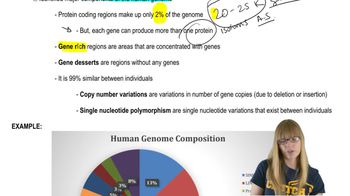Carl Linnaeus, the 18th-century botanist who laid the foundation for the modern system of taxonomic nomenclature, placed chimpanzees and humans in the same genus. Discuss the merits of this classification.
Table of contents
- 1. Introduction to Genetics51m
- 2. Mendel's Laws of Inheritance3h 37m
- 3. Extensions to Mendelian Inheritance2h 41m
- 4. Genetic Mapping and Linkage2h 28m
- 5. Genetics of Bacteria and Viruses1h 21m
- 6. Chromosomal Variation1h 48m
- 7. DNA and Chromosome Structure56m
- 8. DNA Replication1h 10m
- 9. Mitosis and Meiosis1h 34m
- 10. Transcription1h 0m
- 11. Translation58m
- 12. Gene Regulation in Prokaryotes1h 19m
- 13. Gene Regulation in Eukaryotes44m
- 14. Genetic Control of Development44m
- 15. Genomes and Genomics1h 50m
- 16. Transposable Elements47m
- 17. Mutation, Repair, and Recombination1h 6m
- 18. Molecular Genetic Tools19m
- 19. Cancer Genetics29m
- 20. Quantitative Genetics1h 26m
- 21. Population Genetics50m
- 22. Evolutionary Genetics29m
22. Evolutionary Genetics
Phylogenetic Trees
Problem D.10
Textbook Question
Denisovans are known from bones found in Denisova Cave in the Altai Mountains in Siberia, but traces of their DNA are found in Australians and Melanesians, whose ancestors likely migrated across Asia much farther to the south. How can these geographic differences be reconciled?
 Verified step by step guidance
Verified step by step guidance1
Step 1: Understand the context of Denisovans as an archaic human group identified primarily from fossils found in Denisova Cave in Siberia, but whose genetic legacy appears in modern populations far from that location, such as Australians and Melanesians.
Step 2: Recognize that the presence of Denisovan DNA in distant populations suggests historical interbreeding events between Denisovans and the ancestors of these modern groups during their migration.
Step 3: Consider the migration routes of early modern humans out of Africa, which likely passed through Asia and could have overlapped geographically and temporally with Denisovan populations, allowing for gene flow.
Step 4: Explore the concept of gene flow and admixture, where interbreeding between distinct populations results in the transfer of genetic material, explaining how Denisovan DNA could be present in populations far from the original fossil site.
Step 5: Synthesize this information to conclude that the geographic differences can be reconciled by understanding that Denisovans had a wider range than the fossil record alone shows, and that their genetic influence spread through admixture with migrating modern humans across Asia.
 Verified video answer for a similar problem:
Verified video answer for a similar problem:This video solution was recommended by our tutors as helpful for the problem above
Video duration:
1mPlay a video:
Was this helpful?
Key Concepts
Here are the essential concepts you must grasp in order to answer the question correctly.
Ancient Human Migration
Ancient human migration refers to the movement of early human populations across different regions over time. Understanding migration routes helps explain how genetic material from groups like Denisovans spread far from their original locations, such as from Siberia to Southeast Asia and Oceania.
Recommended video:
Guided course

Human Genome Composition
Interbreeding and Genetic Admixture
Interbreeding between distinct hominin groups, such as Denisovans and modern humans, led to genetic admixture. This process results in the presence of Denisovan DNA in modern populations, even if those populations live far from where Denisovan fossils were found.
Recommended video:
Guided course

Descriptive Genetics
Population Genetics and DNA Tracing
Population genetics studies the distribution of genetic variations within and between populations. By analyzing DNA sequences, scientists can trace ancestral relationships and migration patterns, revealing how Denisovan genetic markers appear in distant populations like Australians and Melanesians.
Recommended video:
Guided course

Descriptive Genetics
Related Videos
Related Practice
Textbook Question
562
views


